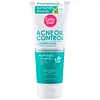What's inside
What's inside
 Key Ingredients
Key Ingredients

 Benefits
Benefits

 Concerns
Concerns

 Ingredients Side-by-side
Ingredients Side-by-side

Water
Skin ConditioningStearic Acid
CleansingGlycerin
HumectantLauric Acid
CleansingPotassium Hydroxide
BufferingMyristic Acid
CleansingDipropylene Glycol
HumectantCocamidopropyl Betaine
CleansingUrea
BufferingGlycol Distearate
EmollientBeeswax
Emulsion StabilisingGlyceryl Stearate
EmollientPEG-100 Stearate
Dipotassium Glycyrrhizate
HumectantNiacinamide
SmoothingAscorbic Acid
AntioxidantTocopherol
AntioxidantSalicylic Acid
MaskingPEG-120 Methyl Glucose Dioleate
EmulsifyingSodium Benzoate
MaskingSodium Cocoyl Isethionate
CleansingMelaleuca Alternifolia Leaf Extract
PerfumingParfum
MaskingDisodium EDTA
Pyrus Malus Fruit Extract
Skin ConditioningWater, Stearic Acid, Glycerin, Lauric Acid, Potassium Hydroxide, Myristic Acid, Dipropylene Glycol, Cocamidopropyl Betaine, Urea, Glycol Distearate, Beeswax, Glyceryl Stearate, PEG-100 Stearate, Dipotassium Glycyrrhizate, Niacinamide, Ascorbic Acid, Tocopherol, Salicylic Acid, PEG-120 Methyl Glucose Dioleate, Sodium Benzoate, Sodium Cocoyl Isethionate, Melaleuca Alternifolia Leaf Extract, Parfum, Disodium EDTA, Pyrus Malus Fruit Extract
Water
Skin ConditioningStearic Acid
CleansingPalmitic Acid
EmollientMyristic Acid
CleansingCocamidopropyl Betaine
CleansingPotassium Hydroxide
BufferingCocamide DEA
EmulsifyingPropylene Glycol
HumectantHydroxyethylcellulose
Emulsion StabilisingMelaleuca Alternifolia Leaf Oil
AntioxidantDisodium EDTA
Ethylhexylglycerin
Skin ConditioningPhenoxyethanol
Preservative3-O-Ethyl Ascorbic Acid
Skin ConditioningCaprylhydroxamic Acid
Hamamelis Virginiana Extract
AntiseborrhoeicCentella Asiatica Extract
CleansingWater, Stearic Acid, Palmitic Acid, Myristic Acid, Cocamidopropyl Betaine, Potassium Hydroxide, Cocamide DEA, Propylene Glycol, Hydroxyethylcellulose, Melaleuca Alternifolia Leaf Oil, Disodium EDTA, Ethylhexylglycerin, Phenoxyethanol, 3-O-Ethyl Ascorbic Acid, Caprylhydroxamic Acid, Hamamelis Virginiana Extract, Centella Asiatica Extract
Ingredients Explained
These ingredients are found in both products.
Ingredients higher up in an ingredient list are typically present in a larger amount.
Cocamidopropyl Betaine is a fatty acid created by mixing similar compounds in coconut oil and dimethylaminopropylamine, a compound with two amino groups.
This ingredient is a surfactant and cleanser. It helps gather the dirt, pollutants, and other impurities in your skin to be washed away. It also helps thicken a product and make the texture more creamy.
Being created from coconut oil means Cocamidopropyl Betaine is hydrating for the skin.
While Cocamidopropyl Betaine was believed to be an allergen, a study from 2012 disproved this. It found two compounds in unpure Cocamidopropyl Betaine to be the irritants: aminoamide and 3-dimethylaminopropylamine. High-grade and pure Cocamidopropyl Betaine did not induce allergic reactions during this study.
Learn more about Cocamidopropyl BetaineDisodium EDTA plays a role in making products more stable by aiding other preservatives.
It is a chelating agent, meaning it neutralizes metal ions that may be found in a product.
Disodium EDTA is a salt of edetic acid and is found to be safe in cosmetic ingredients.
Learn more about Disodium EDTAMyristic Acid is a saturated fatty acid. It is naturally found in milk fat. Other sources include palm oil, coconut oil, and butter fat.
Myristic Acid is an emulsifer and cleanser. As an emulsifer, it stabilizes a product by preventing ingredients from separating. Myristic Acid helps clean your skin by acting as a surfactant. It tends to gather oil and dirt on your skin to be easily rinsed away.
One study from 2021 found Myristic Acid to have anti-inflammatory properties.
Learn more about Myristic AcidPotassium hydroxide is commonly known as caustic potash. It is used to fix the pH of a product or as a cleaning agent in soap. In cleansers, it is used for the saponification of oils.
Sapnification is the process of creating fatty acid metal salts from triglycerides and a strong base. During this process, Potassium Hydroxide is used up and is not present in the final product.
Using high concentrations of Potassium Hydroxide have shown to irritate the skin.
Learn more about Potassium HydroxideStearic Acid is a fatty acid. It is an emollient, emulsifier, and texture enhancer.
As an emollient, stearic acid helps soften skin. It aids the skin's protective barrier by preventing water loss. It also provides a gentle cleansing effect without stripping away natural oils.
Stearic acid may also be used to enhance the texture of products. It can add volume and stabilize ingredients such as water and oil. This can help water and oil ingredients from separating.
Sources of stearic acid include animal or vegetable fats/oils such as coconut or shea. It can be naturally found in butter, cocoa butter, shea butter, vegetable fats, and animal tallow.
This ingredient may not be Malassezia folliculitis, or fungal-acne safe.
Learn more about Stearic AcidWater. It's the most common cosmetic ingredient of all. You'll usually see it at the top of ingredient lists, meaning that it makes up the largest part of the product.
So why is it so popular? Water most often acts as a solvent - this means that it helps dissolve other ingredients into the formulation.
You'll also recognize water as that liquid we all need to stay alive. If you see this, drink a glass of water. Stay hydrated!
Learn more about Water